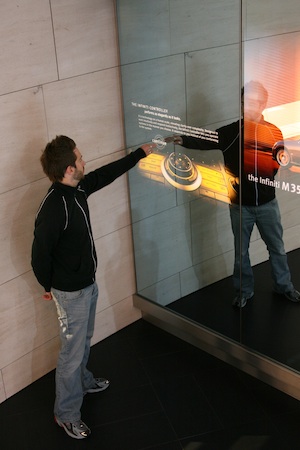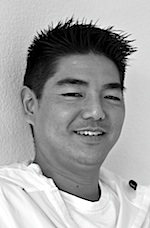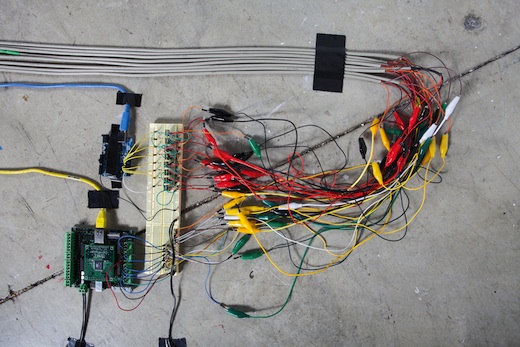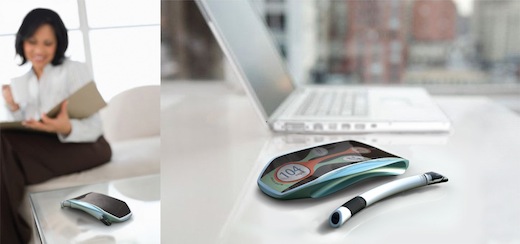
Nikolai Cornell MDP 04 with his Infiniti Interactive Mirrors. Faculty member Phil van Allen consulted on this project.
With recent forecasts predicting that Apple will sell as many as 66 million units of their latest iteration of the iPad this year, its safe to say that what the Cupertino company dubbed as the “post-PC era” is quickly becoming a reality. But the shift from personal computers to tablets is just one aspect of a digital interactive future still being written.
This coming Fall Term, as part of the College’s Create Change initiative, Art Center will launch a new undergraduate Interaction Design degree program, in which students—whether designing a mobile app or a gestural interface for an exhibition—will learn to think deeply about the user’s experience, apply technology creatively and invent new approaches to interaction and design.
We recently sat down with Interaction Design founding faculty members Brian Boyl (Graphic Design, Integrated Studies, Product Design), Philip van Allen (Graduate Media Design) and Jeffrey Higashi (Product Design), who have been busy establishing the framework for the Department’s curriculum in anticipation of the arrival of the new department’s chair. An international search is now underway and an announcement is expected in June.
Dotted Line: Can you describe the academic interaction design landscape and how Art Center’s new program will stand out?
Brian Boyl: There are several graduate programs in interaction design in the United States—Illinois Institute of Technology, New York Univeristy and Carnegie Mellon to name a few—but there aren’t a lot of accredited undergraduate programs. We’d be one of the first undergraduate programs to be launched and absolutely the first to be launched in Southern California. That’s exciting. What we’re doing is looking at the core strengths of Art Center. We think the best move in creating this program is to make sure it strongly integrates with our other departments and channels their strengths.
Phil van Allen: Interaction design is by its very nature collaborative, so the idea is to build a strong program that stands on its own but that also has a kind of permeability. For example, we’ve discussed that students in Interaction Design will take Graphic Design and Product Design courses, because those two disciplines are very central to interaction design. Our students will need to have an exceptional foundation of disciplines to be exceptional interaction designers. And then there’s the core of interaction design itself, which they will have to become experts in.
Dotted Line: Can you explain how strong product design affects an interface?
Jeff Higashi: It really helps you get to the details of creating usable interfaces. It gives you the ability to articulate the visual aspect of interfaces. That can be graphical, in terms of not only what’s on screen, but also the way the keys look or how interaction is broken up visually. It enables you to create instinctive types of interfaces—when you first see it, you immediately have a sense of how it’s supposed to work. It also enables you to bring efficient and accurate tactility to usable interfaces. Sometimes interfaces get very confusing—your cable company’s remote control with a billion keys is a good example. It’s not an efficiently designed solution; the keys are all the same size and made of the same material, meaning you need to turn the lights on to use it. It’s also not a very accurate tactile experience; you can very easily hit the wrong key. Paying attention to those details is one way Art Center’s Interaction Design department will stand apart from other programs.
Dotted Line: What kind of research have you been doing into the world of interaction design beyond the classroom?
PvA: The world of interaction design is at a really interesting moment right now. With the development of HTML5 there’s an opportunity to bring a whole new visual language to the Web. The Web has always been perceived as the poor stepchild of design because it’s so constrained. But now HTML5 allows designers to take a much more interesting approach. The things you can do now with type and image are much more interesting and dynamic. And the advance of technology in general is giving us the opportunity to create a whole new generation of interaction. In the established fields, there’s Web and mobile devices. And then there’s ubiquitous computing, which is an emerging area but one that offers tremendous opportunities for invention and intervention. One of the bigger opportunities is changing technology from a purely functional tool to something that integrates deeply into our lives in a pleasing and natural way.
JH: My research has mainly been in industry practice. I’ve been designing cell phones and mobile communications devices for more than 15 years. I’ve seen the change from tactile-only interfaces—yes, we had actual buttons for numbers!—to the introduction of colored LCD screens to the current touch screens. I started at Nokia in 1995 and during my time there we innovated a number of tactile interfaces—the scroll wheel for navigating lists is an early example. Then I went on create Samsung’s North American Wireless Design Center in 2000, where I worked on all mobile phones and accessories, including Bluetooth headsets. Bluetooth headsets are challenging because their operation is almost completely dependent on tactile feel. Getting the tactile interaction right is important to the overall performance of a product. As you can tell, I’m really geared towards the tactile side of interaction.
Dotted Line: Do you think a return to more tactile interfaces is a direction the industry is heading?
JH: I think it’s inevitable. We’ve got home appliances that are really getting into software-based control systems. The knee-jerk reaction would be to add a touch screen to everything. But imagine controlling your toaster with a touch screen. It’s likely to be overkill and, quite frankly, it’s expensive. Tactile interfaces can help establish a balance between advanced controls and intuitive experiences.
PvA: That’s actually where we see the Interaction Design program having its most immediate impact: in combining and bridging the screen with the tangible. An example I’ve been pointing to recently is the Nest Learning Thermostat. The Nest has been designed so that you simply turn the dial to adjust the temperature. It’s so very natural and simple to use. But underneath that simplicity it’s also responding to the user—it displays a little green leaf when they’re saving energy—as well as communicating with other Nests in the house as well as the Nest servers. And of course the user can modify the Nest’s settings on an iPhone or a web browser. So it’s really a whole system. That’s the future of interaction design.
Dotted Line: What do interaction designers need to succeed in the real world?
BB: A lot of our research involved contacting more than 30 companies—Google, Frog Design, IDEO, Continuum Innovation, Karten Design—and asking them what niches exist out there that Art Center could fill. What we heard back—especially from companies like Johnson Controls and BMW DesignworksUSA, which create tactile interactions for the automobile industry—is that nobody is producing graduates with the type of interaction design experience they need. One executive told us that they put their new hires through two years of internal education just to get them to a point where they’re doing interaction design at a professional level. We also had a roundtable discussion with companies based in Los Angeles. And that was important for us—to ask what does L.A. offer in terms of interaction design that is unique and that we can build upon? We need to start answering that question. That means looking at the entertainment industry, the media industry, the transportation industry, product design, environmental design and health care. Those are areas that Art Center operates very well within.
JH: The ability to tell stories is huge. It a tool that really helps create a better experience. And that’s another way in which this new department will be well positioned—Art Center already has a strong focus on storytelling. In the Product Design Department our students ask: What is the need? What are the conditions of the environment that might affect the ability to use the product? And how do those things work together to deliver an experience that is relevant and also pleasurable? In software development there’s a process called the “agile process,” in which programmers build the software interface, then they test it, then they rebuild it, they test it again. Through storytelling, we’re able to emulate that software development process. We’re able to tell a story of how we envision the user experiencing the product, and then we test it. And if it doesn’t work, then we rewrite the story and refine the interface in order to appropriately improve the user experience. In our classes, we continually rewrite and refine stories every week to make sure we’re incorporating realistic situations and addressing desirable needs.
DL: Doesn’t Art Center already have classes that incorporate elements of interaction design? I’m thinking particularly of Transportation Design, where so many cars now include computer interfaces…
BB: Yes, absolutely. In fact we’re running a class this term sponsored by Fujitsu Ten, a company that creates the computer systems for Toyota. We’ve worked with Fujitsu Ten for a few terms now and the course keeps evolving. Each time we learn more about what it means to have a digital interface in the car—what a designer can do with that in terms of navigation and media sensors and also what you shouldn’t do. Yes, we’re already in that space and we have many classes in interaction design , so this is a natural fit for us. We are leveraging off from what we already know and we we’re already involved in.
DL: Phil, I know that your NETLab Toolkit gives students the ability to integrate hardware, media and interactive behaviors into their projects. Doesn’t that also fit nicely into interaction design?
PVA: Yes, my graduate students in Grad Media Design are definitely already working in this area. For example, I teach a class called Productive Interaction, which is a good example of how interaction design can be approached differently. In that class, we focus on creating systems for people so that they can create their own meaning spaces. Rather than trying to impose a particular kind of experience, the designer creates a context for you to create your own experiences and meanings. [Editor’s note: See the embedded video below for a Productive Interaction student project by current Graduate Media Design students Bora Shin, Mike Manalo and Link Hwang.] Working in that context, my students have done redesigns of Wikipedia and created new kinds of interactive publications. One student created the concept of a hand-held travel guide that’s flexible, foldable and can transform into different shapes. So when you’re walking down the street you can unfold it see it as a map, you can build your own itinerary as you walk around, or you can have it suggest things to you. I see three main parts of interaction design at the very core: designing the screen and physical behavior, which creates interesting and productive dialogs; designing the structure of the content so it’s communicative and useful; and designing the system in which the project exists because everything is networked together.
Art Center is now accepting applications for students entering the Interaction Design program in the 2012 Fall Term. For more information, call Admissions at 626.396.2373 or visit artcenter.edu/ixd














Hi,
Thank you four your nice writing on Designing Experiences, Systems and Solutions: Art Center’s New Interaction Design Program
Thanks.